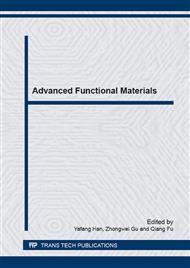[1]
C.S. Brazel and N.A. Peppas, Synthesis and characterization of thermo- and chemo-mechanically responsive poly (N-isopropylacrylamide-co-methacrylic acid) hydrogels, Macromolecules. 28 (1995) 8016-8020.
DOI: 10.1021/ma00128a007
Google Scholar
[2]
L. Dong, A.K. Agarwal, D.J. Beebe, H.R. Jiang, Adaptive liquid microlenses activated by stimuli-responsive hydrogels, Nature. 442 (2006) 551-554.
DOI: 10.1038/nature05024
Google Scholar
[3]
K.E. Crompton, J.D. Goud, R.V. Bellamkonda, T.R. Gengenbach, D.I. Finkelstein, M.K. Horne, J.S. Forsythe, Polylysine-functionalised thermoresponsive chitosan hydrogel for neural tissue engineering, Biomaterials. 28 (2007) 441-449.
DOI: 10.1016/j.biomaterials.2006.08.044
Google Scholar
[4]
M.M. Ei-Masry, M.M.M. EInashar, H.M. El-Sherif, Amphoteric hydrogels for immobilization of enzymes using template polymerization technique, J. Appl. Polym. Sci. 106 (2007) 3571-3580.
DOI: 10.1002/app.26931
Google Scholar
[5]
Y.J. Lee, P.V. Braun, Tunable inverse opal hydrogel pH sensors, Adv. Mater. 15 (2003) 563-566.
DOI: 10.1002/adma.200304588
Google Scholar
[6]
A. Richter, G. Paschew, S. Klatt, J. Lienig, K.F. Arndt, H.J.P. Adler, Review on hydrogel-based pH sensors and microsensors, Sensors. 8 (2008) 561-581.
DOI: 10.3390/s8010561
Google Scholar
[7]
G. Jiang, F.Q. Liu, Network structure and compositional effects on tensile mechanical properties of hydrophobic association hydrogels with high mechanical strength, Polymer. 51 (2010) 1507-1515.
DOI: 10.1016/j.polymer.2010.01.061
Google Scholar
[8]
U. Gulyuz, O. Okay, Self-healing polyacrylic acid hydrogels, Soft Matter. 9 (2013) 10287-10293.
DOI: 10.1039/c3sm52015c
Google Scholar
[9]
G.Q. Jiang, F.Q. Liu, Construction and properties of hydrophobic association hydrogels with high mechanical strength and reforming capability, Macromol. Mater. Eng. 294 (2009) 815-820.
DOI: 10.1002/mame.200900160
Google Scholar
[10]
K. Haraguchi, T. Takehisa, Nanocomposite hydrogels: a unique organic-inorganic network structure with extraordinary mechanical, optical, and swelling/de-swelling properties, Adv. Mater. 14 (2002) 1120.
DOI: 10.1002/1521-4095(20020816)14:16<1120::aid-adma1120>3.0.co;2-9
Google Scholar
[11]
K. Haraguchi, M. Ebato, T. Takehisa, Polymer–clay nanocomposites exhibiting abnormal necking phenomena accompanied by extremely large reversible elongations and excellent transparency, Adv. Mater. 18 (2006) 2250-2254.
DOI: 10.1002/adma.200600143
Google Scholar
[12]
Q. Zhang, T. Zhang, T. He, L. Chen, Removal of crystal violet by clay/PNIPAm nanocomposite hydrogels with various clay contents, Appl. Clay Sci. 90 (2014) 1-5.
DOI: 10.1016/j.clay.2014.01.003
Google Scholar
[13]
L. Xiong, X. Hu, X. Liu, Z. Tong, Network chain density and relaxation of in situ synthesized polyacrylamide/hectorite clay nanocomposite hydrogels with ultrahigh tensibility, Polymer. 49 (2008) 5064-5071.
DOI: 10.1016/j.polymer.2008.09.021
Google Scholar
[14]
G.Q. Jiang, F.Q. Liu, Self-healing Mechanism and mechanical behavior of hydrophobic association hydrogels with high mechanical strength, J. Macromol. Sci., Part A: Pure Appl. Chem. 47 (2010) 335-342.
DOI: 10.1080/10601320903539272
Google Scholar
[15]
A. Hill, F. Candau, J. Selb, Properties of hydrophobically associating polyacrylamides: influence of the method of synthesis, Macromolecules. 26 (1993) 4521-4532.
DOI: 10.1021/ma00069a017
Google Scholar
[16]
K.C. Dowling, J.K. Thomas, A novel micellar synthesis and photophysical characterization of water-soluble acrylamide-styrene block copolymers, Macromolecules. 23 (1990) 1059-1064.
DOI: 10.1021/ma00206a025
Google Scholar
[17]
S. Biggs, J. Selb, F. Candau, Effect of surfactant on the solution properties of hydrophobically modified polyacrylamide, Langmuir. 8 (1992) 838-847.
DOI: 10.1021/la00039a018
Google Scholar
[18]
A.J. Dualeh, C.A. Steiner, Hydrophobic microphase formation in surfactant solutions containing an amphiphilic graft copolymer, Macromolecules. 23 (1990) 251-255.
DOI: 10.1021/ma00203a043
Google Scholar
[19]
K. Haraguchi, H.J. Li, K. Matsuda, Mechanism of forming organic/inorganic network structures during in-situ free-radical polymerization in PNIPA-clay nanocomposite hydrogels, Macromolecules. 38 (2005) 3482-3490.
DOI: 10.1021/ma047431c
Google Scholar
[20]
S. Li, X. Liu, Synthesis, characterization and evaluation of semi-IPN hydrogels consisted of poly (methacrylic acid) and guar gum for colon-specific drug delivery, Adv. Polym. Tech. 19 (2008) 371-376.
DOI: 10.1002/pat.1018
Google Scholar
[21]
P. Liu, L.X. Zhang, Adsorption of dyes from aqueous solutions or suspensions with clay nano-adsorbents, Sep. Purif. Technol. 58 (2007) 32-39.
DOI: 10.1016/j.seppur.2007.07.007
Google Scholar


